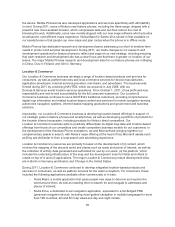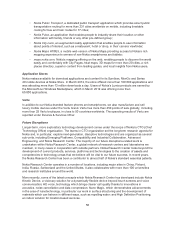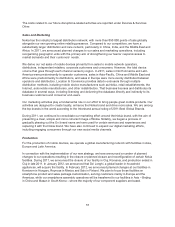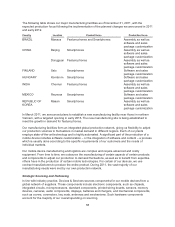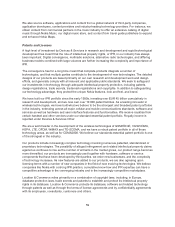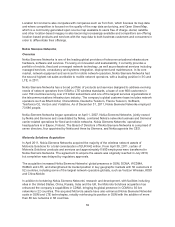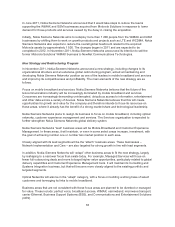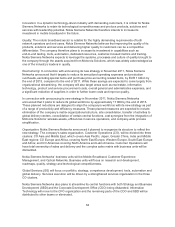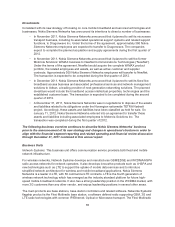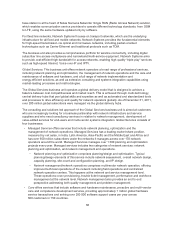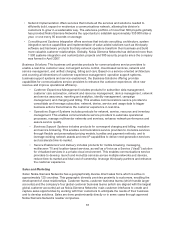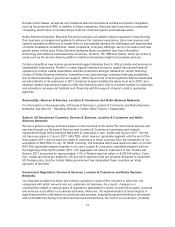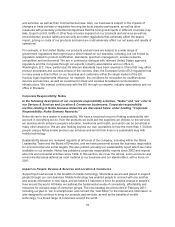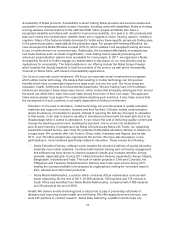Nokia 2011 Annual Report Download - page 66
Download and view the complete annual report
Please find page 66 of the 2011 Nokia annual report below. You can navigate through the pages in the report by either clicking on the pages listed below, or by using the keyword search tool below to find specific information within the annual report.Innovation: In a dynamic technology-driven industry with demanding customers, it is critical for Nokia
Siemens Networks to retain its technological competitiveness and produce products, solutions and
services with leadership potential. Nokia Siemens Networks therefore intends to increase its
investment in mobile broadband in the future.
Quality: The mobile broadband sector is notable for the highly demanding requirements of both
network operators and end users. Nokia Siemens Networks believes that improving the quality of its
products, solutions and services and delivering higher quality to customers can be a competitive
differentiator. The company therefore plans to increase its investment in capabilities such as
end-to-end testing, tools, automation, dedicated resources, customer-focused metrics and training.
Nokia Siemens Networks expects to leverage the systems, processes and culture of quality brought to
the company through the assets acquired from Motorola Solutions, which was widely acknowledged as
one of the industry’s leaders in quality.
Restructuring: In connection with announcing its new strategy in November 2011, Nokia Siemens
Networks announced that it targets to reduce its annualized operating expenses and production
overheads, excluding special items and purchase price accounting related items, by EUR 1 billion by
the end of 2013, compared to the end of 2011. While these savings are expected to come largely from
organizational streamlining, the company will also target areas such as real estate, information
technology, product and service procurement costs, overall general and administrative expenses, and
a significant reduction of suppliers in order to further lower costs and improve quality.
In connection with announcing its new strategy in November 2011, Nokia Siemens Networks
announced that it plans to reduce its global workforce by approximately 17 000 by the end of 2013.
These planned reductions are designed to align the company’s workforce with its new strategy as part
of a range of productivity and efficiency measures. These planned measures are expected to include
elimination of the company’s matrix organizational structure, site consolidation, transfer of activities to
global delivery centers, consolidation of certain central functions, cost synergies from the integration of
Motorola Solutions’ wireless assets, efficiencies in service operations, and company-wide process
simplification.
Organization: Nokia Siemens Networks announced it planned to reorganize its structure to reflect the
new strategy. The company’s sales organization, Customer Operations (CO), will be divided into three
clusters: CO Asia and Middle East, which covers Asia Pacific, Japan, Greater China, India and Middle
East regions; CO Europe and Africa, covering North East Europe, Western Europe, South East Europe
and Africa; and CO Americas covering North America and Latin America. Customer Operations will
have total ownership of sales and delivery and the complex sales matrix with business units will be
dismantled.
Nokia Siemens Networks’ business units will be Mobile Broadband, Customer Experience
Management, and Optical Networks. Business units will focus on research and development,
roadmaps, quality, strategy and technological competitiveness.
Global Services (GS) will focus on portfolio, strategy, competence development, tools, automation and
global delivery. Services execution will be driven by a strengthened services organization in the three
CO clusters.
Nokia Siemens Networks also plans to streamline its central functions with both Strategy and Business
Development (SBD) and the Corporate Development Office (CDO) being disbanded. Information
Technology will move to the CFO organization and the remaining parts of the CDO and SBD will be
distributed to other teams or eliminated.
64



